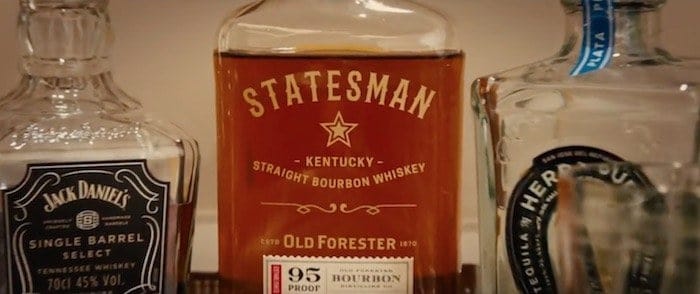ET was paid to eat Reese’s Pieces.
You probably know that. The placement of products in movies and TV shows is nothing new. It can be a very effective form of advertising. “E.T., the Extraterrestrial” sold a lot of candy. When James Dean famously used an Ace comb in 1955’s “Rebel Without a Cause,” comb sales went through the roof.
Alcoholic beverages have long played the game too. In 1951, Gordon’s Gin got a boost from Humphrey Bogart in “The African Queen.” Yes, he played a degenerate drunk, but he was Humphrey Bogart, and the Gordon’s folks were delighted. Gordon’s Gin appeared in the film and Bogart posed for a Gordon’s ad.
‘Product placement’ refers to the practice of paying a filmmaker to show a product in a film, but not all appearances of brand-name products are paid placements. Filmmakers often use brands, whether it’s a Ford truck or a bottle of Coca-Cola, to communicate something about a setting or character.

A good example involving whiskey is in “French Connection II” (1975). Gene Hackman’s ‘Popeye’ Doyle is a fish-out-of-water in Paris, and nobody paid to be in the scene where he struggles with the language barrier in a small café. First he orders “Four Roses straight up, water on the side.” In response to the barman’s shrug he switches to Jack Daniel’s, and finally settles for ‘whisky’ which, he discovers to his chagrin, means Scotch outside the U.S.
Jack Daniel’s Tennessee Whisky, the most commonly seen whiskey brand in all media, usually doesn’t pay for placement. Often their appearance is not exactly edifying, such as when John Belushi’s ‘Bluto’ character in “Animal House” chugs an entire bottle of Old No. 7.
The first known appearance of Jack Daniel’s in a film was 1963’s “Hud,” starring Paul Newman. Although he famously drank prodigious amounts of Budweiser beer in real life, Newman’s cinematic drinking was more diverse. In “The Hustler” (1961), he pounds J. T. S. Brown bourbon while his rival, Minnesota Fats, chooses a mild blended whiskey, possibly a placebo. Fast Eddie’s drinking symbolizes his loss of control.
Sometimes a director uses a particular brand in a scene just because it is a personal favorite, and sometimes the results are hilarious. In the TV series “Justified,” every dive bar in Kentucky seems to have a bottle of Van Winkle bourbon on hand. In the real world, even the toniest bars have trouble keeping the stuff in stock.
Jack Daniel’s owner Brown-Forman did pay to have Pierce Brosnan’s James Bond drink Jack Daniel’s instead of his famous vodka martini in “GoldenEye,” Brosnan’s first Bond film. Judi Dench’s ‘M’ pours it for him and refers to it as ‘bourbon.’ The producers used several product placements to update Bond’s image in that 1995 reboot, also switching his ride from an Aston-Martin to a BMW.
In “Bull Durham” (1988), Kevin Costner’s Crash Davis gets drunk on Jim Beam, and it is as much about brand development as it is about character development. Some placements are clumsy. In “Spider-Man” (2002), when the rich villain Norman Osborn (Willem Dafoe) pours himself a Maker’s Mark, the scene is so label-perfect it could be mistaken for a Maker’s Mark ad.
Today, major movies spend as much on promotion as they do on production, and product tie-ins are a big part of it. A tie-in goes way beyond traditional product placement into full blown co-promotion. Brown-Forman’s placement of Old Forester in the recent “Kingsman” sequel was matched by a “Statesman” edition of the venerable bourbon, with special packaging and a unique flavor profile. Publicity for the bourbon, and by extension the movie, began in May. “Kingsman, the Golden Circle,” released in late September, has made $380 million so far, even though reviewers such as the Chicago Tribune’s Michael Phillips characterize it as “James Bond for idiots.” Reviews of the bourbon have been better.
Even more recently, the long-awaited “Blade Runner” sequel turns an incidental appearance by Johnnie Walker Black in the original film into a major tie-in for this one, with its own special blend release of the whiskey, in part created–and enthusiastically hawked–by the film’s director. Walker parent Diageo even gets a shout-out of its own in the weird corporate dystopia of L. A. in 2049, where Atari and Pan Am are still major brands.
Although “Kingsman, the Golden Circle” and “Blade Runner 2049” are fantasies, the use of real brands on screen is a way to connect fictional characters to the real world. You may not hunt replicants, but you can drink what Deckard drinks, and isn’t that just as good?









